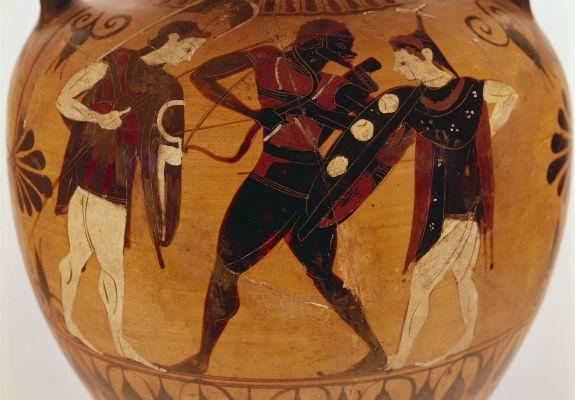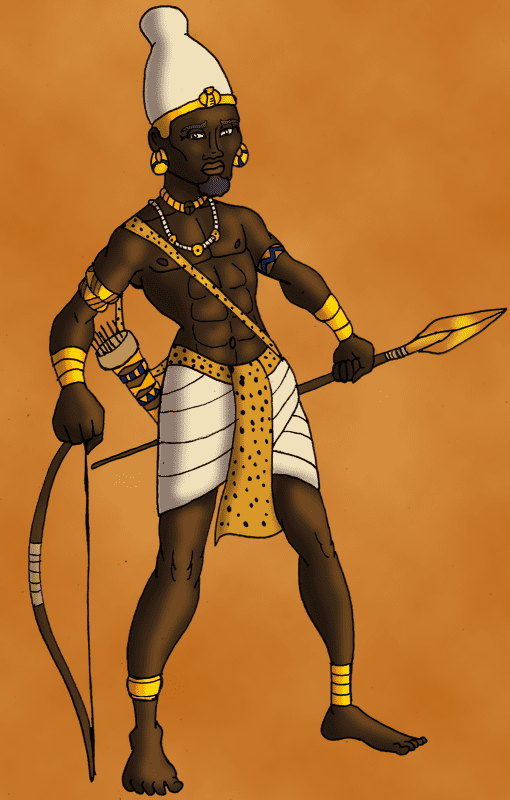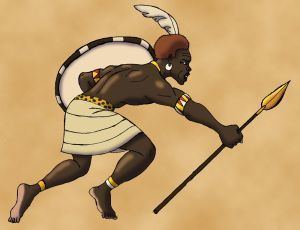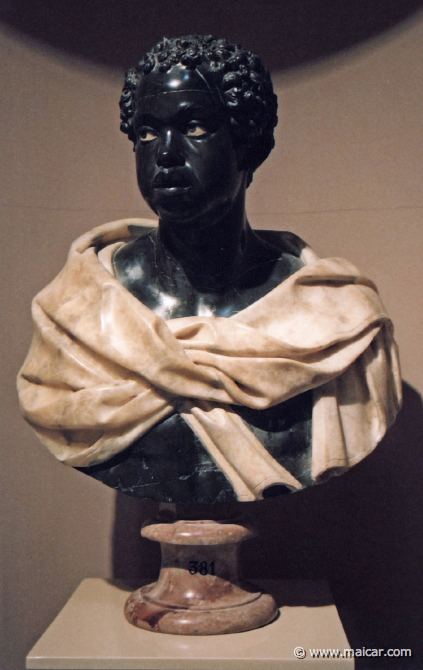 | ||
Similar Antilochus, Agamemnon, Priam, Paris, Ajax | ||
Memnon mythology
In Greek mythology, Memnon (Greek: Mέμνων) was an Ethiopian king and son of Tithonus and Eos. As a warrior he was considered to be almost Achilles' equal in skill. During the Trojan War, he brought an army to Troy's defense and had killed Antilochus during a fierce battle. The death of Memnon echoes that of Hector, another defender of Troy whom Achilles also killed out of revenge for a fallen comrade, Patroclus. After Memnon's death, Zeus was moved by Eos' tears and granted him immortality. Memnon's death is related at length in the lost epic Aethiopis, composed after The Iliad circa the 7th century BC. Quintus of Smyrna records Memnon's death in Posthomerica. His death is also described in Philostratus' Imagines.
Contents
- Memnon mythology
- Memnon in Quintus of Smyrnas Posthomerica
- Memnon in Africa
- Memnon son of Eos Dawn and Tithonus
- Memnon father of Thor
- References

Memnon in Quintus of Smyrna's Posthomerica

Memnon journeying from the western Ocean with his army of Ethiopians, arrives at Troy in the immediate aftermath of an argument between Polydamas, Helen, and Priam that centres on whether or not the Aethiopian King will show up at all. Memnon's army is described as being too big to be counted and his arrival starts a huge banquet in his honour. As per usual the two leaders (Memnon and, in this case, Priam) end the dinner by exchanging glorious war stories, and Memnon's tales lead Priam to declare that the Aethiopian King will be Troy's saviour. Despite this, Memnon is very humble and warns that his strength will, he hopes, be seen in battle, although he believes it is unwise to boast at dinner. Before the next day's battle, so great is the divine love towards Memnon that Zeus makes all the other Olympians promise not to interfere in the fighting. In battle, Memnon kills Nestor's son, Antilochos, after Antilochos has killed Memnon's dear comrade, Aesop. Seeking vengeance and despite his age, Nestor tries to fight Memnon but the Aethiopian warrior insists it would not be just to fight such an old man, and respects Nestor so much that he refuses to fight. In this way, Memnon is seen as very similar to Achilles – both of them have strong sets of values that are looked upon favourably by the warrior culture of the time. When Memnon reaches the Greek ships, Nestor begs Achilles to fight him and avenge Antilochos, leading to the two men clashing while both wearing divine armour made by Hephaestus, making another parallel between the two warriors. Zeus favours both of them and makes each man tireless and huge so that the whole battlefield can watch them clash as demigods. Eventually, Achilles stabs Memnon through the heart, causing his entire army to flee in terror. In honour of Memnon, the Gods collect all the drops of blood that fall from him and use them to form a huge river that on every anniversary of his death will bear the stench of human flesh. The Aethiopians that stayed close to Memnon in order to bury their leader are turned into birds (which we now call Memnons) and they stay by his tomb so as to remove dust that gathers on it.
Memnon in Africa

Roman writers and later classical Greek writers such as Diodorus Siculus believed Memnon hailed from "Aethiopia", a geographical area in Africa, usually south of Egypt. Because the original historical work by Arctinus of Miletus only survives in fragments, most of what is known about Memnon comes from post-Homeric Greek and Roman writers. Homer only makes passing mention to Memnon in the Odyssey. Herodotus called Susa "the city of Memnon," Herodotus describes two tall statues with Egyptian and Ethiopian dress that some, he says, identify as Memnon; he disagrees, having previously stated that he believes it to Sesostris. One of the statues was on the road from Smyrna to Sardis. Herodotus described a carved figure matching this description near the old road from Smyrna to Sardis.

Pausanias describes how he marveled at a colossal statue in Egypt, having been told that Memnon began his travels in Africa:

In Egyptian Thebes, on crossing the Nile to the so-called Pipes, I saw a statue, still sitting, which gave out a sound. The many call it Memnon, who they say from Aethiopia overran Egypt and as far as Susa. The Thebans, however, say that it is a statue, not of Memnon, but of a native named Phamenoph, and I have heard some say that it is Sesostris. This statue was broken in two by Cambyses, and at the present day from head to middle it is thrown down; but the rest is seated, and every day at the rising of the sun it makes a noise, and the sound one could best liken to that of a harp or lyre when a string has been broken.
Philostratus of Lemnos in his work Imagines, describes artwork of a scene which depicts Memnon:

Now such is the scene in Homer, but the events depicted by the painter are as follows: Memnon coming from Ethiopia slays Antilochus, who has thrown himself in front of this father, and he seems to strike terror among the Achaeans – for before Memnon's time black men were but a subject for story – and the Achaeans, gaining possession of the body, lament Antilochus, both the sons of Atreus and the Ithacan and the son of Tydeus and the two heroes of the same name.
According to Manetho Memnon and the 8th Pharaoh of the 18th dynasty Amenophis was one and the same king.
According to Homer in the Iliad, the fame of the Achaeans will reach as far as the Dawn spreads, the geography of this is referring to the western ends of the earth, when Dawn and the sun spreads over the earth starting from the east they journey west to Oceanus near land of the Ethiopians toward the sunset and the Atlas Mountains. And when Homer speaks of the fame of the Achaeans reaching as far as the dawn spreads, he is referring to the land of Memnon, when King Priam sent a message to Memnon to come to Troy and help him fight against the invading Greeks.
Memnon son of Eos (Dawn) and Tithonus
According to ancient Greek poets, Memnon's father Tithonus was snatched away from Troy by the goddess of dawn Eos and was taken to the ends of the earth on the coast of Oceanus. This literally means he was carried by the east wind and was driven to the western ends of the earth beyond the Ocean or Pillars of Hercules. According to Hesiod Eos bore to Tithonus bronzed armed Memnon, the King of the Ethiopians and lordly Emathion. Zephyrus, god of the west wind, like Memnon was also the first-born son of Eos (east wind) by another father Astraeus, making him the brother of Memnon. According to Quintus Smyrnaeus, Memnon said himself that he was raised by the Hesperides on the coast of Oceanus. Memnon dwelling on the western Ocean and his father being driven there would make him the son of dawn (the east) as in the son of Troy rather than the son of eastern Asia as earlier scholars have proposed based on their opinion. Hesiod makes it clear that the son of Dawn (east) originally means west, making Memnon a colonist (son) from the east and king of the west. And this actually makes the most sense, because as Eos the Dawn Goddess rises from the east before her father Hyperion (the sun) she journeys to the western ends of the earth were she and her father the Sun God sleeps. To the knowledge of the Greeks the farthest west ended at the land of Atlas towards the Hesperides on the African coast south of the Atlantic Ocean. There is a statue of Memnon west of Luxor in Egypt known today as the Colossi of Memnon. According to the ancient Greek historians this statue of Memnon made a sound at morning time that meant Memnon was speaking to his mother Dawn as she rises in the east while he dwells in the west, making him the son of dawn (east) and ruler of the west.
Memnon father of Thor
In the Prologue of Snorri Sturluson's Prose Edda, Memnon is cited as the father of the Germanic God Thor.
Near the earth's centre was made that goodliest of homes and haunts that ever have been, which is called Troy, even that which we call Turkland. This abode was much more gloriously made than others, and fashioned with more skill of craftsmanship in manifold wise, both in luxury and in the wealth which was there in abundance. There were twelve kingdoms and one High King, and many sovereignties belonged to each kingdom; in the stronghold were twelve chieftains. These chieftains were in every manly part greatly above other men that have ever been in the world. One king among them was called Múnón or Mennón; and he was wedded to the daughter of the High King Priam, her who was called Tróán; they had a child named Trór, whom we call Thor.
